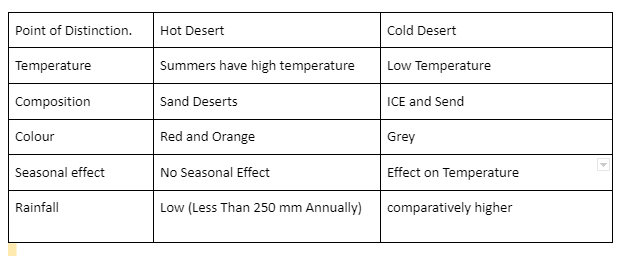Life in Deserts
Rainfall—or, more accurately, the lack of it—is what distinguishes deserts. Most deserts receive less than ten inches of precipitation per year, and evaporation typically outnumbers rainfall. Deserts – areas where more water evaporates from the ground than is replaced by precipitation.
Some characteristics of Deserts are:
- Extreme Temperatures (Both Hot and Cold)
- Very Low Rainfall
- Lack of Vegetation
- High Evaporation
Difference Between hot and Cold Desert

The Hot Desert – Sahara:
- It is the largest desert in the world. Its area is around 8.54 million sq. km
- It spreads across eleven nations. These are Egypt, Algeria, Libya, Mali, Algeria, Mauritania, Morocco, Niger, Sudan, Tunisia, and Western Sahara
- Climate: The environment of the Sahara Desert is burning hot and dry. It has a short rainy season. The sky is cloudless and clear. Days are unfathomably hot. The temperatures during the day might take off as high as 50°C, warming up the sand and the uncovered rocks, which thus transmits heat, making everything around hot. The evenings might be cold, with temperatures approaching zero degrees
- Flora and Fauna: Vegetation in the Sahara Desert includes cactus, date palms, and acacia. Camels, hyenas, jackals, foxes, scorpions, and a variety of snakes and reptiles are the animals generally found in the region
- Tribes: The Bedouins and Tuaregs. These gatherings are itinerant clans raising domesticated animals like goats, sheep, camels, and ponies
- Agriculture: The desert in the Sahara and the Nile Valley in Egypt upholds settled populaces. Harvests like rice, wheat, grain, and beans are also developed synthetically. Egyptian cotton is well known around the world
The Cold Desert – Ladakh
- Region: Ladakh is a chilled desert lying in the Great Himalayas, on the eastern side of Jammu and Kashmir. The Karakoram Range in the north and the Zanskar mountains divide it
- Rivers: A few waterways course through Ladakh, Indus being the most significant. Other rivers of the region are Zanskar, Shyok and Suru
- Climate: The elevation in Ladakh differs from around 3000 m in Kargil to more than 8,000 m in Karakoram. Because of its high elevation, the environment is incredibly cold and dry. As it lies in downpour shadow spaces of the Himalayas, there is little precipitation, as low as 10 cm consistently. The region encounters freezing winds and tiring hot daylight
- Flora and fauna: Due to high aridity, the vegetation is sparse. There are meagre patches of grasses and bushes for creatures to nibble
- Forests of willows and poplars are found in the valleys. Natural product trees like apples, apricots, and pecans sprout during the summers
- The creatures of Ladakh are wild goats, wild sheep, yak, and extraordinary sorts of canines
- The creatures are raised to accommodate the milk, meat, and stows away. Yak’s milk is utilised to make cheddar and spread. The hair of the sheep and goat is used to make woollen
- People: Buddhist monasteries speck the Ladakhi scene with their customary ‘gompas.’ Some well-known monasteries are Hemis, Thiksey, Shey, and Lamayuru
- Agriculture: In the mid-year season, individuals are caught up with developing grain, potatoes, peas, beans, and turnip. In winter, individuals keep themselves occupied with celebrations and services
- Connectivity: Leh, the capital of Ladakh, spring–green is very much associated both by street and air. The National Highway 1A associates Leh to Kashmir Valley through the Zoji la Pass
Conclusion:
Life in Desert can be extremely difficult, with extreme temperatures and difficulty of means. People have managed to live there within limited resources. Some of these Deserts are a popular destination for vacations as well.
 Profile
Profile Settings
Settings Refer your friends
Refer your friends Sign out
Sign out












